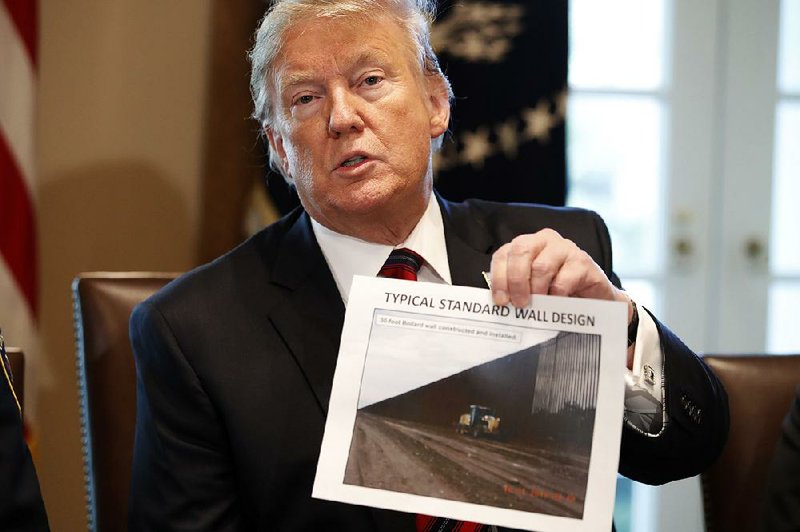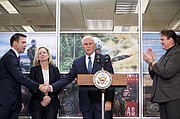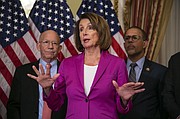WASHINGTON -- President Donald Trump on Friday backed off of the idea of immediately declaring a national emergency to build a wall on the U.S.-Mexico border, reversing days of signals that he might soon declare the emergency amid a protracted standoff with Democrats over a partial shutdown of the federal government.
"What we're not looking to do right now is national emergency," he said Friday afternoon, surrounded by law enforcement officials at a White House roundtable. "I'm not going to do it so fast."
The president has said for days he might declare a national emergency to expedite construction of the wall -- and his administration has asked agencies to begin preparations.
But he has gotten sharp pushback, even from Republicans, at the notion of declaring such an emergency. His lawyers have privately warned that he could be on shaky footing with such a move, according to people familiar with the discussions.
The Democratic-led House held its final votes of the week Friday, including on a measure to ensure that federal workers who are furloughed receive back pay once the government reopens.
About 800,000 workers missed a paycheck Friday as the impasse between Trump and Democrats stretched into its 21st day.
The House approved the measure on a 411-7 vote, after Senate passage Thursday under a shortcut procedure called unanimous consent, in which a bill is deemed passed if no member objects.
During the brief Senate consideration, Majority Leader Mitch McConnell, R-Ky., said, "I had an opportunity to talk to President Trump a few moments ago and wanted to indicate to our colleagues that he will sign the bill that we have been discussing here to guarantee that government workers who have been displaced as a result of the shutdown will ultimately be compensated. So I want to ease their anxiety about that particular possibility."
Officials said the bill could be presented quickly to the White House for signature as a stand-alone measure. In past shutdowns, such language more commonly has been attached to the broader measures that ultimately restored agency funding.
The House also passed another bill that would reopen more shuttered government departments -- but it was already declared dead on arrival in the GOP-controlled Senate because of a veto threat from Trump.
The bill would reopen the Interior Department, the Environmental Protection Agency, the National Park Service and several other agencies.
It passed 240-179, with 10 Republicans joining all Democrats in the chamber supporting it.
All four members of the House from Arkansas voted against the measure.
Rep. Tom Cole, R-Okla., called the exercise "a charade" because Senate leaders have already indicated they do not plan to vote on the bill and Trump has said he would not sign it.
"If anybody thinks this is accomplishing anything, it's not," Cole said.
"We've wasted the week because our friends can't sit down and split the difference," he added. "I don't think anyone looks particularly good in this. ... This will end another sad week in this chamber."
As of early Friday afternoon, there were no signs of serious negotiations underway, and leaders of both chambers announced no plans to meet before Monday, all but ensuring that the partial government shutdown would become the longest in U.S. history.
Earlier Friday, Trump took to Twitter to tout his trip to the border Thursday, writing, "I just got back and it is a far worse situation than almost anyone would understand, an invasion!"
"The Democrats, Cryin' Chuck and Nancy don't know how bad and dangerous it is for our ENTIRE COUNTRY," Trump wrote, referring to Senate Minority Leader Charles Schumer, D-N.Y., and House Speaker Nancy Pelosi, D-Calif.
Trump asserted that without a wall -- or steel barrier -- "our Country cannot be safe."
Pelosi said Friday that Democrats have not felt any political pressure to give in to Trump's wall demands.
"No, except to stay firm," she said.
She dismissed Trump's negotiating style as one destined to fail. "His version of a negotiation is, 'Do everything I want,'" she said.
Other Democrats pushed back in television appearances and speeches on the floor.
"One person is responsible for shutting down government: Donald Trump," House Majority Leader Steny Hoyer, D-Md., told his colleagues. He argued that Democrats are open to tightening border security but are not going to "waste money" on what he characterized as an antiquated approach advocated by Trump.
As part of an effort to continue to build a public case for the wall, Vice President Mike Pence spoke Friday with Customs and Border Protection employees, assuring them, "We're going to build that wall."
"Let me assure you that in a challenging time ... I'm here to say we are with you and we are going to continue to stand with you until you have the resources and reforms to do your jobs," Pence said.
The agency is among those with employees working without pay because of the shutdown.
Later Friday afternoon, Trump held what was billed as a "roundtable discussion on border security" at the White House with state, local and community leaders.
Arkansas Attorney General Leslie Rutledge was among those attending.
"It was a great conversation with the president about some of the issues that we're facing," she said.
In Arkansas, "approximately 2.4 percent of our population are illegal immigrants," she said.
With the border insufficiently secure, criminals are able to exploit that weakness, she said.
"It's human trafficking as well as drug problems," she added.
DISASTER SPENDING
Amid the stalemate, the White House has been laying the groundwork for a declaration of a national emergency to build Trump's border wall.
The administration is eyeing unused money in the Army Corps of Engineers budget, specifically a disaster-spending bill passed by Congress last year that includes $13.9 billion allocated but not spent for civil works projects, The Washington Post reported Thursday.
The list includes dozens of flood-control projects in areas affected by recent natural disasters, including the Texas coastline inundated by Hurricane Harvey and parts of Puerto Rico battered by Hurricane Maria. The military construction budget is also being looked at as a potential source for unspent funds, with billions more potentially available there.
Other possibilities included tapping asset forfeiture funds, including money seized by the Department of Justice from drug kingpins, according to a congressional Republican not authorized to speak publicly about private conversations.
Trump's advisers, including his son-in-law and senior adviser, Jared Kushner, have urged him to try to find approaches other than declaring an emergency. Kushner's role was first reported by The Wall Street Journal.
The advisers have warned him of a range of possible negative outcomes, particularly the risk of losing in court, people familiar with the discussions said.
The notion of declaring a national emergency to bypass Congress has divided Republicans, some of whom see it as an encroachment on congressional authority.
"I think the president should not do it," Sen. Charles Grassley, R-Iowa, told reporters Friday. "I think as a member of Congress I ought to be very selfish about the constitutional powers that we have to appropriate money. I think it might be a bad precedent."
Sens. Tim Kaine and Mark Warner, Democrats from Virginia, both objected to the use of military funding for the wall while speaking with reporters Friday after a meeting with furloughed workers.
Kaine, who sits on the Armed Services Committee and is the only senator with a child on active duty, said military construction dollars are used for things like removing lead from the water supply in troops' housing and hardening overseas bases to better resist a terrorist attack.
"There is a lot of emergency expenditures that are already in the queue," he said. "I'd like the ability to compare, well what's more of an emergency right now."
Warner said the courts would have to decide if money could be spent on the wall after Congress appropriated it for other uses.
"Let's face it," Warner said. "This is an attempt to basically go around the law, to go around the rules. That's why you even see pushback from some in his own party."
On Friday, Puerto Rico Gov. Ricardo Rossello also strongly objected to the idea of diverting money intended for hurricane mitigation.
"No wall should be funded by the pain and suffering of citizens of the United States who have suffered a tragedy and loss through a natural disaster," he said in a statement.
Rep. Mark Meadows, R-N.C., a leader of the conservative House Freedom Caucus, said that unless Republicans and Democrats strike an unlikely compromise, "I fully expect him to declare a national emergency."
"Most conservatives want it to be the last resort he would use," Meadows said. "But those same conservatives, I'm sure if it's deployed, would embrace him as having done all he could do to negotiate with Democrats."
Pelosi told reporters that she expects the government to reopen if Trump declares a national emergency.
"Well, I think that would be his purpose," she said. "Well, I guess his purpose is to build a wall. But remember this about the wall: This isn't a wall between Mexico and the United States."
She said Trump is instead trying to distract from special counsel Robert Mueller's investigation into Russia's election interference and other challenges his administration is facing.
"This is a wall between his failures of his administration, problems that he might have with the Mueller [investigation], people leaving his Cabinet in dismay and disgrace," Pelosi said. "That's the wall he's trying to build between public opinion and what is going on. And so this is his big diversion, and he's a master of diversion."

Information for this article was contributed by John Wagner, Erica Werner, Josh Dawsey, Mike DeBonis, Paul Kane, Eric Yoder and Jenna Portnoy of The Washington Post; by Michael Tackett and Julie Hirschfeld Davis of The New York Times; by Jonathan Lemire, Lisa Mascaro, Jill Colvin, Catherine Lucey, Colleen Long, Alan Fram, Lolita Baldor, Darlene Superville, Zeke Miller and Laurie Kellman of The Associated Press; and by Frank E. Lockwood of the Arkansas Democrat-Gazette.
A Section on 01/12/2019


